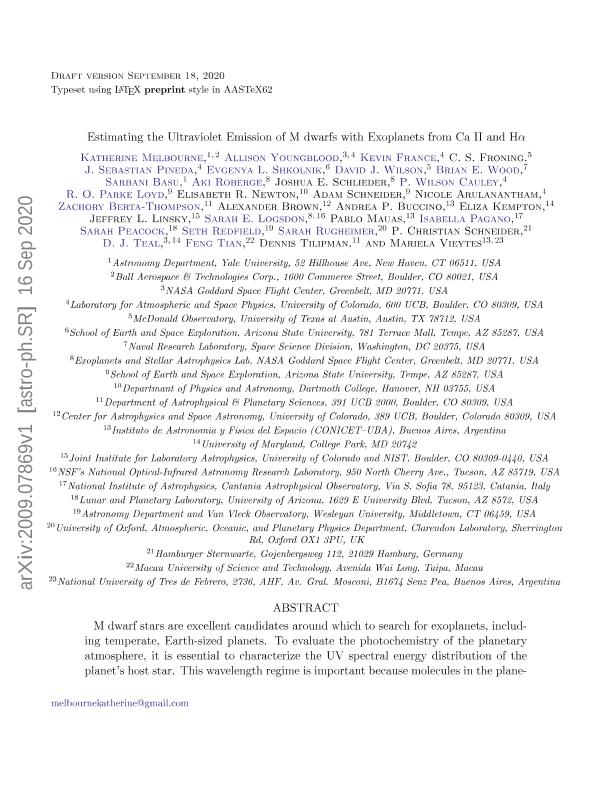Artículo
Estimating the ultraviolet emission of M dwarfs with exoplanets from Ca II and Hα
Melbourne, Katherine; Youngblood, Allison; France, Kevin; Froning, Cynthia S.; Pineda, J. Sebastian; Shkolnik, Evgenya L.; Wilson, David J.; Wood, Brian E.; Basu, Sarbani; Roberge, Aki; Schlieder, Joshua E.; Cauley, P. Wilson; Loyd, R. O. Parke; Newton, Elisabeth R.; Schneider, Adam; Arulanantham, Nicole; Berta Thompson, Zachory; Brown, Alexander; Buccino, Andrea Paola ; Kempton, Eliza; Linsky, Jeffrey L.; Logsdon, Sarah E.; Mauas, Pablo Jacobo David
; Kempton, Eliza; Linsky, Jeffrey L.; Logsdon, Sarah E.; Mauas, Pablo Jacobo David ; Pagano, Isabella; Peacock, Sarah; Redfield, Seth; Rugheimer, Sarah; Schneider, P. Christian; Teal, D. J.; Tian, Feng; Tilipman, Dennis; Vieytes, Mariela Cristina
; Pagano, Isabella; Peacock, Sarah; Redfield, Seth; Rugheimer, Sarah; Schneider, P. Christian; Teal, D. J.; Tian, Feng; Tilipman, Dennis; Vieytes, Mariela Cristina
 ; Kempton, Eliza; Linsky, Jeffrey L.; Logsdon, Sarah E.; Mauas, Pablo Jacobo David
; Kempton, Eliza; Linsky, Jeffrey L.; Logsdon, Sarah E.; Mauas, Pablo Jacobo David ; Pagano, Isabella; Peacock, Sarah; Redfield, Seth; Rugheimer, Sarah; Schneider, P. Christian; Teal, D. J.; Tian, Feng; Tilipman, Dennis; Vieytes, Mariela Cristina
; Pagano, Isabella; Peacock, Sarah; Redfield, Seth; Rugheimer, Sarah; Schneider, P. Christian; Teal, D. J.; Tian, Feng; Tilipman, Dennis; Vieytes, Mariela Cristina
Fecha de publicación:
12/2020
Editorial:
IOP Publishing
Revista:
Astronomical Journal
ISSN:
0004-6256
e-ISSN:
1538-3881
Idioma:
Inglés
Tipo de recurso:
Artículo publicado
Clasificación temática:
Resumen
M dwarf stars are excellent candidates around which to search for exoplanets, including temperate, Earth-sized planets. To evaluate the photochemistry of the planetary atmosphere, it is essential to characterize the UV spectral energy distribution of the planet's host star. This wavelength regime is important because molecules in the planetary atmosphere such as oxygen and ozone have highly wavelength-dependent absorption cross sections that peak in the UV (900-3200 Å). We seek to provide a broadly applicable method of estimating the UV emission of an M dwarf, without direct UV data, by identifying a relationship between noncontemporaneous optical and UV observations. Our work uses the largest sample of M dwarf star far- and near-UV observations yet assembled. We evaluate three commonly observed optical chromospheric activity indices-Hα equivalent widths and log10 LHα/Lbol, and the Mount Wilson Ca II H&K S and RHK indices-using optical spectra from the HARPS, UVES, and HIRES archives and new HIRES spectra. Archival and new Hubble Space Telescope COS and STIS spectra are used to measure line fluxes for the brightest chromospheric and transition region emission lines between 1200 and 2800 Å. Our results show a correlation between UV emission-line luminosity normalized to the stellar bolometric luminosity and Ca II RHK with standard deviations of 0.31-0.61 dex (factors of ∼2-4) about the best-fit lines. We also find correlations between normalized UV line luminosity and Hα log10 LHα/Lbol and the S index. These relationships allow one to estimate the average UV emission from M0 to M9 dwarfs when UV data are not available.
Palabras clave:
Stellar chromospheres
,
M Dwarfs
,
Exoplanets
Archivos asociados
Licencia
Identificadores
Colecciones
Articulos(IAFE)
Articulos de INST.DE ASTRONOMIA Y FISICA DEL ESPACIO(I)
Articulos de INST.DE ASTRONOMIA Y FISICA DEL ESPACIO(I)
Citación
Melbourne, Katherine; Youngblood, Allison; France, Kevin; Froning, Cynthia S.; Pineda, J. Sebastian; et al.; Estimating the ultraviolet emission of M dwarfs with exoplanets from Ca II and Hα; IOP Publishing; Astronomical Journal; 160; 6; 12-2020; 1-22
Compartir
Altmétricas



